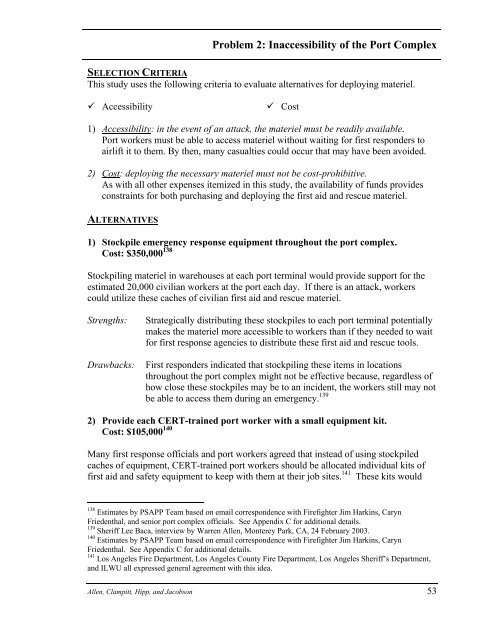Port Security Applied Policy Project - Belfer Center for Science and ...
Port Security Applied Policy Project - Belfer Center for Science and ...
Port Security Applied Policy Project - Belfer Center for Science and ...
Create successful ePaper yourself
Turn your PDF publications into a flip-book with our unique Google optimized e-Paper software.
Problem 2: Inaccessibility of the <strong>Port</strong> Complex<br />
SELECTION CRITERIA<br />
This study uses the following criteria to evaluate alternatives <strong>for</strong> deploying materiel.<br />
¸ Accessibility ¸ Cost<br />
1) Accessibility: in the event of an attack, the materiel must be readily available.<br />
<strong>Port</strong> workers must be able to access materiel without waiting <strong>for</strong> first responders to<br />
airlift it to them. By then, many casualties could occur that may have been avoided.<br />
2) Cost: deploying the necessary materiel must not be cost-prohibitive.<br />
As with all other expenses itemized in this study, the availability of funds provides<br />
constraints <strong>for</strong> both purchasing <strong>and</strong> deploying the first aid <strong>and</strong> rescue materiel.<br />
ALTERNATIVES<br />
1) Stockpile emergency response equipment throughout the port complex.<br />
Cost: $350,000 138<br />
Stockpiling materiel in warehouses at each port terminal would provide support <strong>for</strong> the<br />
estimated 20,000 civilian workers at the port each day. If there is an attack, workers<br />
could utilize these caches of civilian first aid <strong>and</strong> rescue materiel.<br />
Strengths: Strategically distributing these stockpiles to each port terminal potentially<br />
makes the materiel more accessible to workers than if they needed to wait<br />
<strong>for</strong> first response agencies to distribute these first aid <strong>and</strong> rescue tools.<br />
Drawbacks: First responders indicated that stockpiling these items in locations<br />
throughout the port complex might not be effective because, regardless of<br />
how close these stockpiles may be to an incident, the workers still may not<br />
be able to access them during an emergency. 139<br />
2) Provide each CERT-trained port worker with a small equipment kit.<br />
Cost: $105,000 140<br />
Many first response officials <strong>and</strong> port workers agreed that instead of using stockpiled<br />
caches of equipment, CERT-trained port workers should be allocated individual kits of<br />
first aid <strong>and</strong> safety equipment to keep with them at their job sites. 141 These kits would<br />
138 Estimates by PSAPP Team based on email correspondence with Firefighter Jim Harkins, Caryn<br />
Friedenthal, <strong>and</strong> senior port complex officials. See Appendix C <strong>for</strong> additional details.<br />
139 Sheriff Lee Baca, interview by Warren Allen, Monterey Park, CA, 24 February 2003.<br />
140 Estimates by PSAPP Team based on email correspondence with Firefighter Jim Harkins, Caryn<br />
Friedenthal. See Appendix C <strong>for</strong> additional details.<br />
141 Los Angeles Fire Department, Los Angeles County Fire Department, Los Angeles Sheriff’s Department,<br />
<strong>and</strong> ILWU all expressed general agreement with this idea.<br />
Allen, Clampitt, Hipp, <strong>and</strong> Jacobson 53
















